Mojave Preserve, and Desert Peace
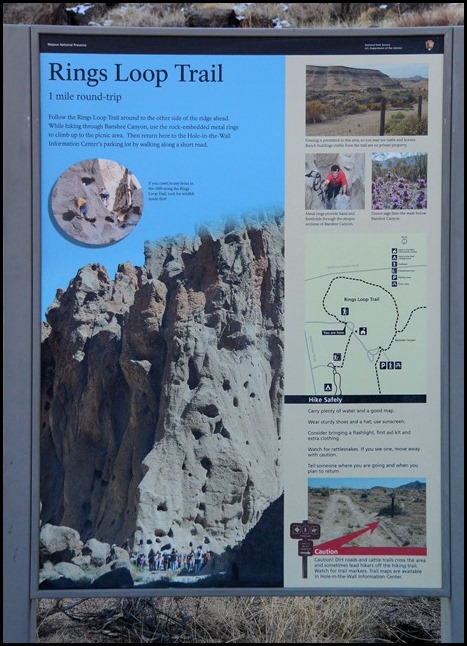 We’ve been here before, enough times I’ve lost count. And I’ve written about the Mojave many times – – you can search the blog for past stories and anecdotes. This winter, our stop here was as enjoyable as ever, perhaps more-so. The peace and quiet of the desert, the absence of any agenda or goals, all combined to grant us a blissful week of camping, relaxing, and just poking around.
We’ve been here before, enough times I’ve lost count. And I’ve written about the Mojave many times – – you can search the blog for past stories and anecdotes. This winter, our stop here was as enjoyable as ever, perhaps more-so. The peace and quiet of the desert, the absence of any agenda or goals, all combined to grant us a blissful week of camping, relaxing, and just poking around.
One of our favorite hikes is this little one-mile trail near our camp at Hole in the Wall (35.0453° N, 115.3934° W). For such a short trek, it’s full of interesting features – – it passes through cattle grazing land, past Indian petroglyphs, and cuts through a tiny slot canyon. We hike it at least once every time we’ve come to the area. I’ve described the “tour” briefly below; you can find more pix and comments in earlier posts – – HERE is one of them.
As we walked the trail clockwise, we came past the petroglyphs and into view of the access road going into the back country (Wild Horse Canyon Road).
South-facing slopes are favorites for barrel cacti. For thermal reasons (I presume), they flourish here when they are not found just a few hundred yards away on cooler terrain. Perhaps it keeps them from freezing, staying as warm as possible all day long in the low southern sun. For sure they love that sun, for shaded slopes don’t have any barrel cactus residents.
About three-quarters of the way around the Loop, Banshee Canyon comes into view. At some vantage points, it looks like an axe cleft the formation, leaving a deep gouge.
When you get closer, that axe cleft isn’t so perfect, and it’s easy to wonder if there is any passage through the imposing vertical rock walls.
Deeper into the crevice, there appears to be a water-worn rift – – –
– – – and although it looks nearly impossible, there is a rugged path into its depths.
As the passage narrows and twists, it comes up against two successive vertical cascades, each only a foot or two wide and 15-20 feet high. Originally, it would take a rope, or Jackie-Chan-style “chimney” scaling – – but somewhere back in time, the NPS installed some robust steel eyebolts and rings to make the climb more accessible (and safe) to the average hiker. This section is the second near-vertical climb. Some rings are a bit of a reach for shorter folks.
For more photos, see my previous posts, or do a search for “rings loop trail” and you find dozens of hits.
We exited the loop near sunset, and by that time the local small game animals were starting to come out for their evening forage. I managed to get a combination shot here – – a cottontail (left near the purplish bush) and a jackrabbit (to the right) posed long enough to grab the camera.
One of the features of the area (and part of the rationale for making it a Preserve) is the variety of flora. It’s very hard to show in a photograph, but this is not a typical sage-and-creosote desert landscape. There are scores, if not hundreds, of diverse plants such as cholla and yucca and grasses (shown), plus numerous cacti, mormon tea, paper bag plants, rabbit brush, joshua trees, prickly pear, barrel cactus, etc etc. Many more than I can recognize or whose names I can remember. This picture also hints at the vastness of the Preserve. 2,500 square miles is a LOT of empty space, and the feeling is marvelous.
Speaking of marvelous feelings – – can you tell how nice it was to relax in camp that evening?
Early one chilly morning, the frost on Ralph’s bed cover started to melt in the rising sun. A tiny desert wren dropped in for a quick drink.
On a different, warmer day (not many of them to be had), we decided to fire up Ralph for some longer-distance exploring. We planned to be pretty careful, since the desert roads can be changed radically by even a little bit of wet weather. And we had had more than a little bit of late. We figured to take a known road and see how it had fared, and then check with Rangers on some previously unexplored routes.
In fact, right out of the gate, so to speak, the big wide smooth Wild Horse Canyon Road (west of camp) – – wasn’t so wide and smooth. Not anything to give us any trouble, but certainly no super-highway. Washouts, and even complete re-routings, were at several different sections. I guess the Park Service doesn’t care for hauling out broken tourists’ cars, because they had the hazards pretty well flagged with cones. They don’t have the equipment or manpower to do any repairs, but they can at least keep the unwary from driving into a three-foot-deep ditch. (Although some of the tourists we’ve met might get stuck anyway; there’s a dufus in every crowd, and we have seen cones driven over.)
Parts of the road serve as natural waterways for storm runoff. You can tell how often any real rains come through, because the local vegetation gets to growing up to 6-8′, with commensurate root systems – – and then a flash flood comes along and scours away all the dirt. This mesquite tree had as much root structure below the ground as it did branches above.
More evidence of efforts to prevent people from harming themselves. Folks not familiar with the back country seem to feel pretty invincible in their cars, and have been known to simply drive into a deep crossing and float away. No standing water for us that day though.
Coming down the Cedar Canyon Road, toward Cima Road, we can see traipsing off into the distance the old pioneer and Indian trail. It scratches away across the desert, eventually going up over that distant rise and well beyond. This is one of the more visible segments of the 138-mile-long Mojave Road, about which I’ve written in previous posts. (Do a search on my blog for it, or for “mojave preserve”, to see more notes from past wanderings.)
But this day, we were not planning on a Mojave Road trek. Instead, we turned left on Kelso-Cima Road and went to the Kelso Depot visitors’ center. We just wanted to check their bookstore for anything new, and ask about road conditions on the driving options we were considering. The Park Service is keeping the building in great shape, and on this Christmas Week weekday a fair sized crowd was flowing in and out.
Since our last visit, the Depot has been considerably expanded, with lots more art and exhibits and a short film. Off in one end of the building is a restored railroad management office, complete with mechanical typewriter, telegraph key, and early style telephone/microphone. Nicely done.
We asked at Kelso about a back-country road, way south of the Depot, that we had never been on. The gal told us that the Rangers had been on it, thought it was mighty steep, and said they hoped they wouldn’t have to drive it ever again. Shoot, that didn’t sound so bad – – we thought we’d give it a try. After all, she didn’t tell us that someone died on it or anything. ![]()
We knew full well that it might be impassable, especially after the recent weather. And it was getting pretty late – – darkness is a lousy time to explore an iffy road. It wasn’t a no-go, and it wasn’t s sure bet by any means.
So we kept our options open, and tentatively started east out the road. It works southeast, and goes to the Vulcan Mine in the Providence Mountains. The mine is about 15 miles southeast of camp, so if we could make it through, we’d cut off a lot of less interesting paved miles going way south around the mountain range.
As the road headed up into the hills, it was obvious that this had once been a long, paved thoroughfare. The Vulcan Mine was once a booming concern, especially during WW2, when more than 1,500 people were resident at Kelso (now about 8-10). Heavy mining equipment and business vehicles made their way back and forth with regularity, as the mine churned out iron and rare metals over its lifespan.
But time and desert heat have evaporated the oil and tar holding the old asphalt together. The road consists now mostly of un-bound gravel, washed-out gullies, and thin haunting crusts to remind us of its former grandness.
The mine tailings come into view and the road is still pretty tame. Up at the mine, a thin dirt road encircles the old pit. There is no vegetation on the pit’s walls, and the very bottom is filled with an evil-looking pool. These old mines used a multitude of chemical techniques, including cyanide leaching. Some of them still have some nasty residues, although Vulcan is not known to be one of them. Regardless, we didn’t want to have a lot to do with that ominous pond.
All around the mining area are leavings from the years-long operations. Concrete foundations, mostly, but not a lot of any iron or equipment. Here’s a set of concrete tank supports. Fuel? Water? Don’t know. With the excellent service road, all the metal stuff was likely hauled out for salvage value.
Going beyond the mine, we passed our last chance to take a “civlized” (aka “boring”) route back to camp. No worries, we knew we could come back to the easy route if need be. We headed out the increasingly rough and rocky roadway, full of stones and ruts and sharp-edged boulders, and showing no sign of ever having been a “real” road. This was not surprising, since all traffic and commerce with the mine would have been via Kelso and the once-paved avenue.
As the road deteriorated, we traversed some fairly abrupt hills and gullies. We started wondering out loud just exactly what those Rangers might have meant by “steep”. We climbed over one pretty tough hill, tires just starting to slip a bit, and thought well this ain’t so bad – – and then we saw it – – – –
– – – this damn thing looked pretty scary. Like coming up on vertical. And off-camber, slanted hard to the left. And rutted, and loose.
[Side Note: The problem with steep hills is not the obvious thing, like slipping or not getting up – – it’s steering. The weight of the vehicle transfers to the rear tires, and the front tires are so light that eventually they have no steering effect. When that happens, you can’t choose whether to go left or right; the terrain tends to make that decision for you. And if you can’t make it up the hill, then you have to back down the hill, also with no damn steering. It’s one of the scariest things in off-roading. The only thing more scary is “side-hilling” where your vehicle points sideways instead of straight uphill or downhill. Under these conditions, a rut or rock can flip the entire vehicle over, and it will not stop rolling until the bottom of the hill. This can be extremely unpleasant.]
All that said (and running through our minds), we took a shot at it.
All in all, it wasn’t as bad as we feared. We made it in one try, partly because we had pretty good traction in the rain-dampened dirt, and partly due to my magnificent driving skills. At least, that’s what I told Karin.
On the far side, the road was MUCH more tame, but there were still some tricky spots. Entering this gulch, I knew I was going to get some air under the diagonal tires, so Karin was kind enough to capture the moment – – –
– – – see, Ralph has about 12″ of suspension travel in the rear, but this ditch needed maybe 16″. No worries, Ralph’s TruTrak limited-slip axle kept things under control.
The remainder of the road was rougher than a corn cob, but not particularly challenging except for a bit of blurred vision. We never ran into anything that made us want to go back to one of our “escape plan” routes (besides, neither of us wanted to go down that damn hill). As we neared the big power lines, the rocky road even smoothed out a bit for the last few miles. We jounced our way back to the paved road, and drove back into camp right around dark. Not too bad timing for an extemporaneous day.
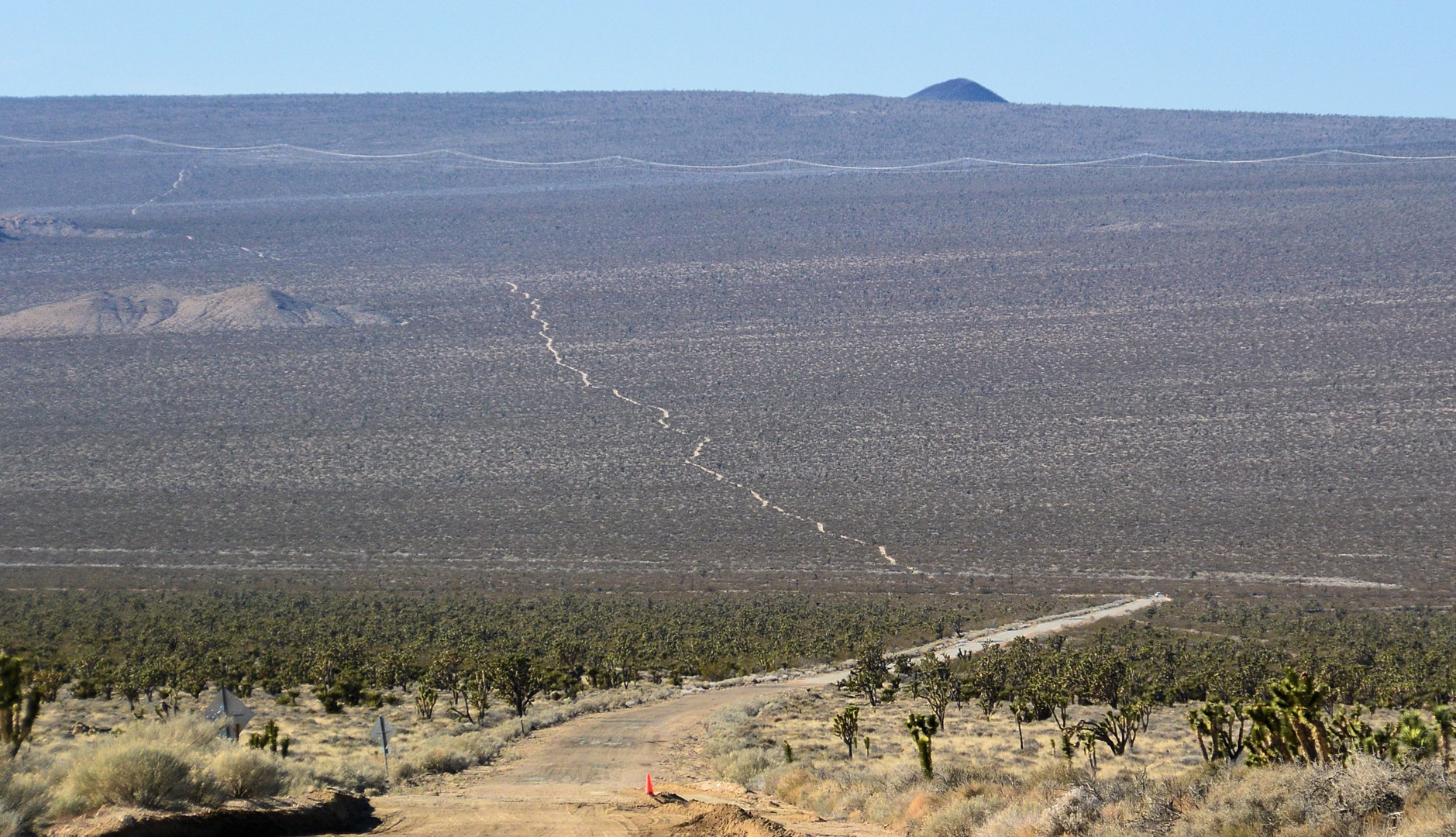
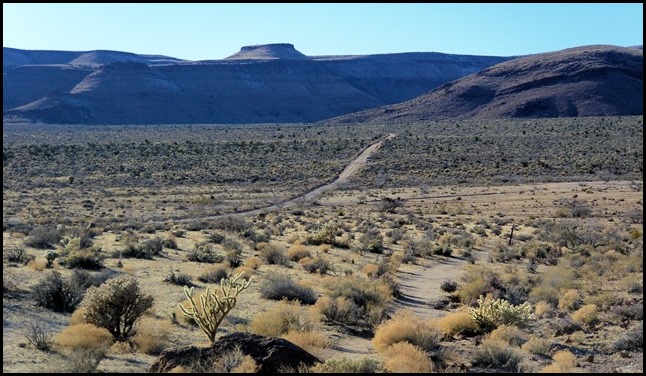
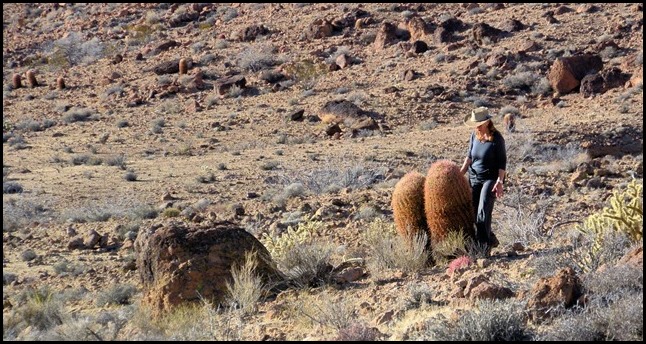
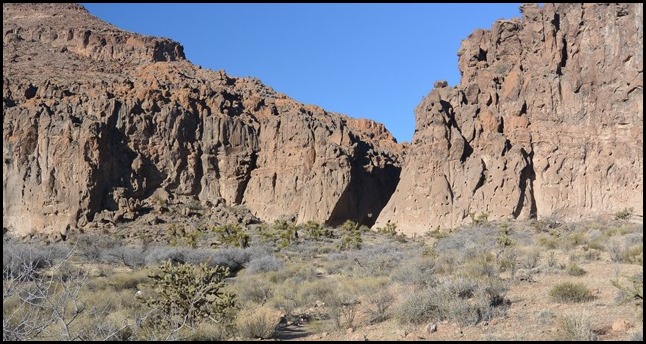
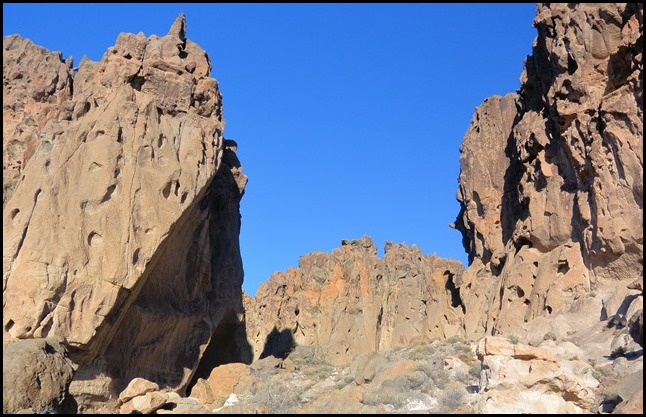
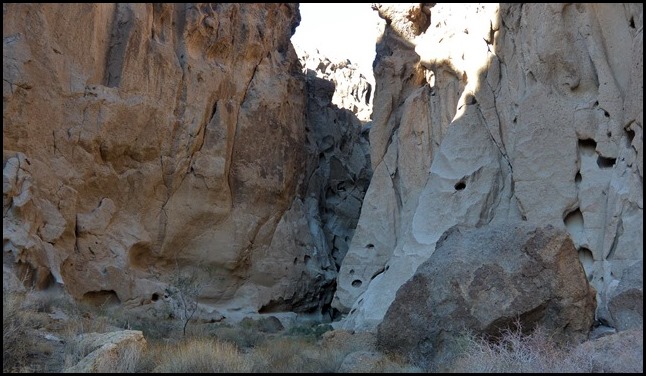
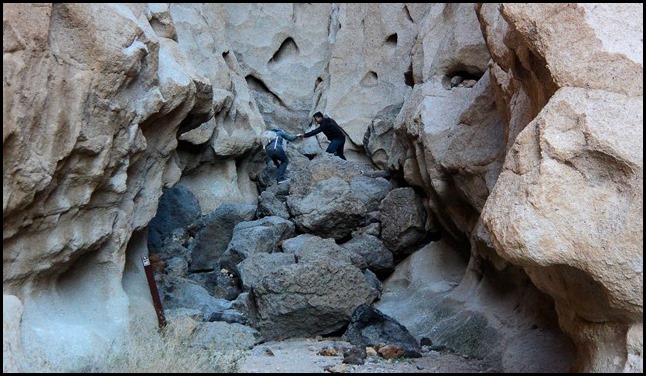
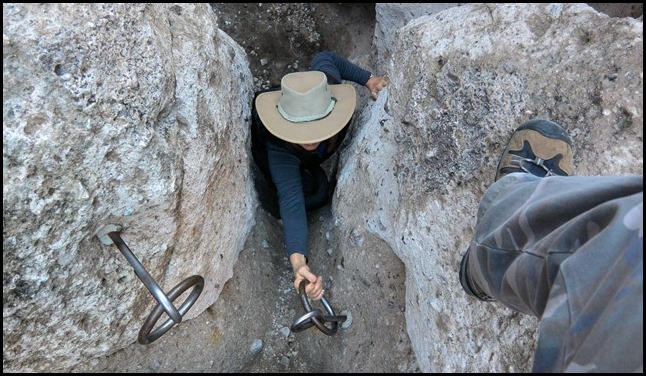
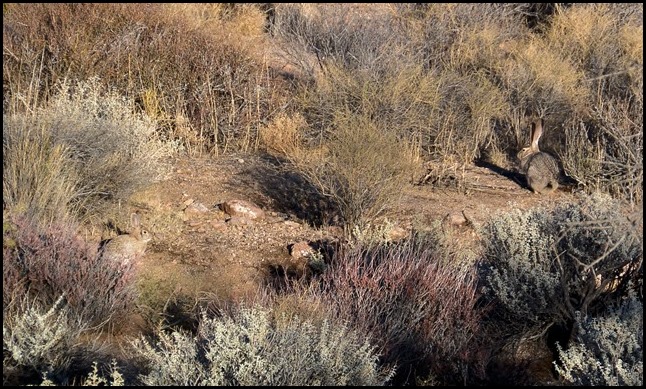
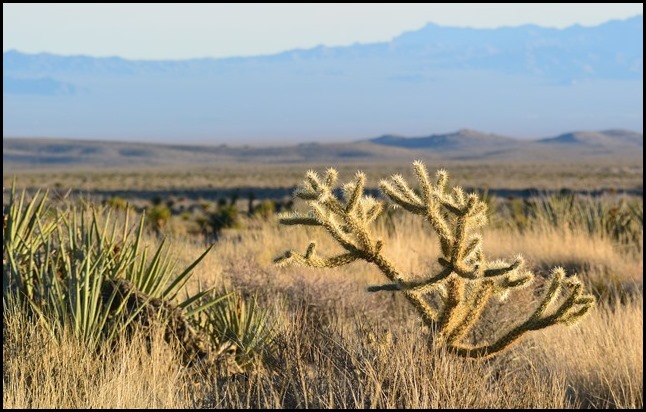
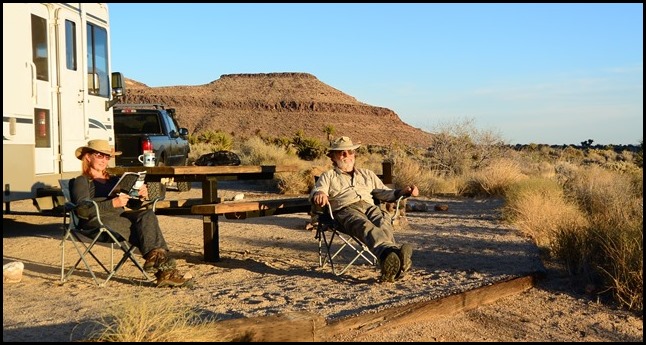
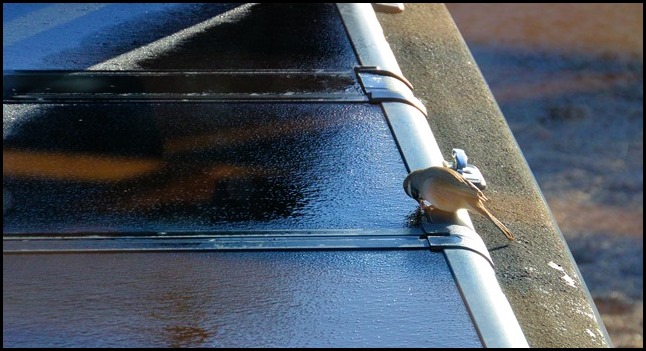
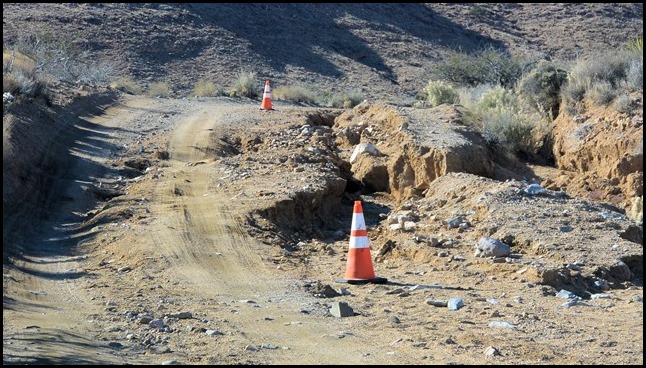
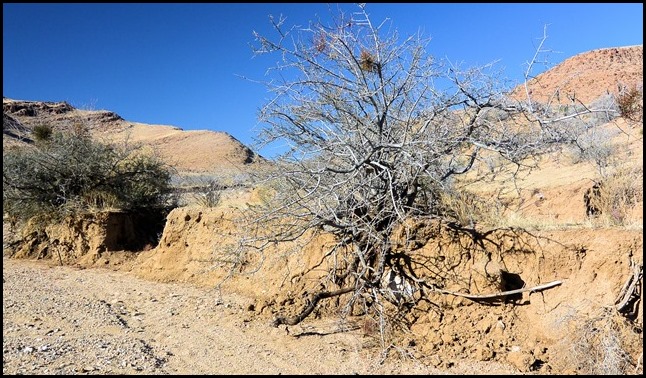
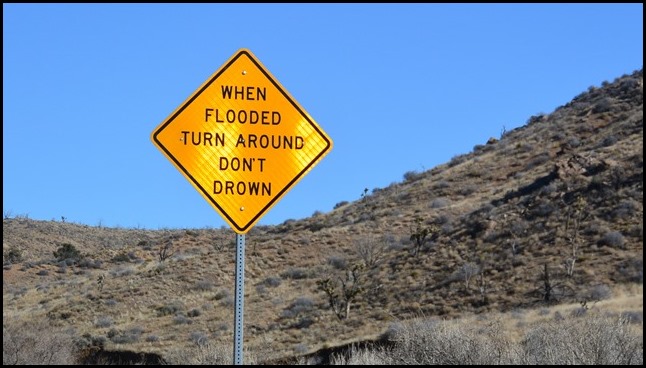
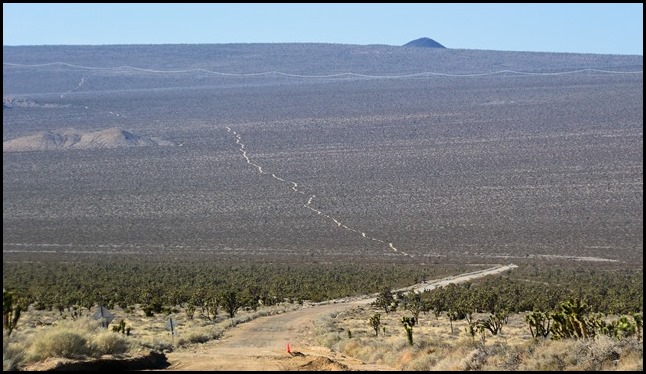
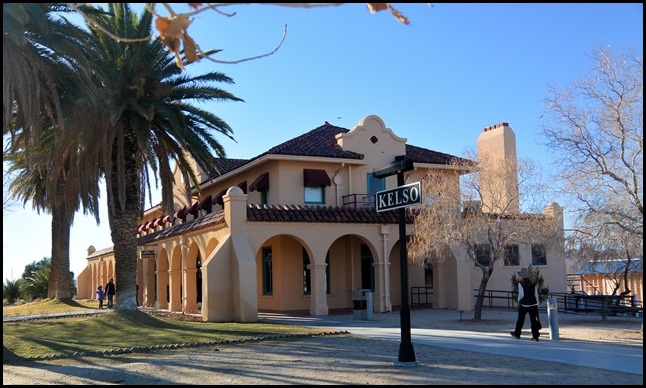
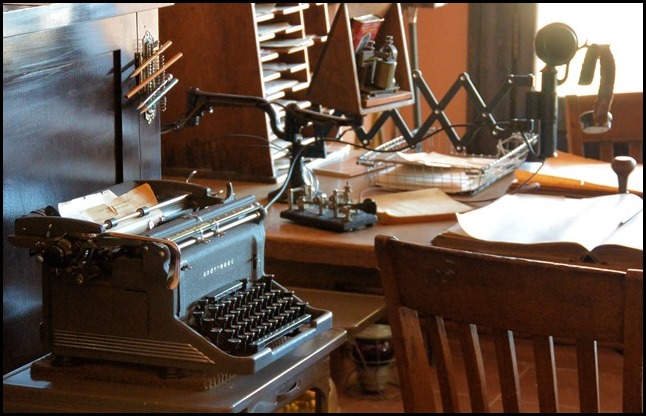
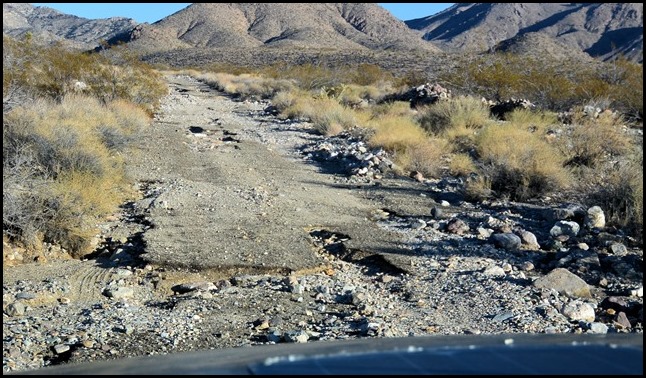
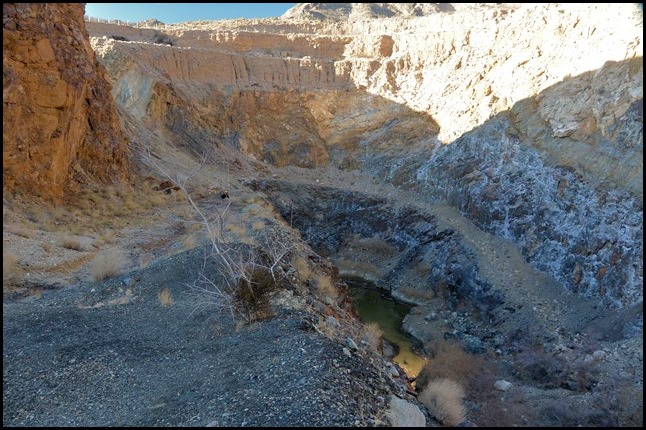
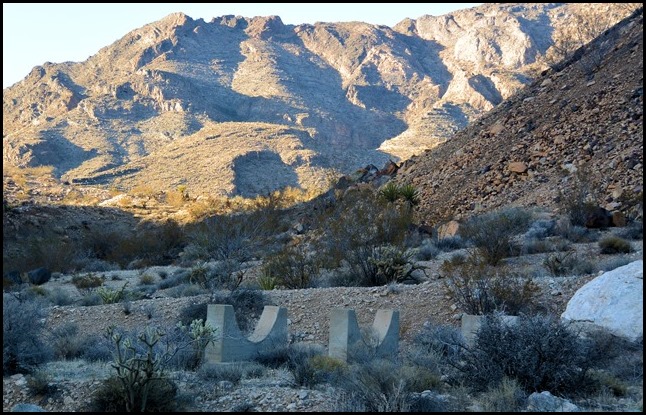
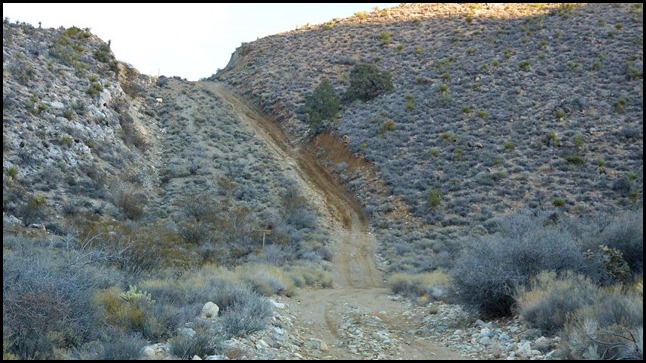
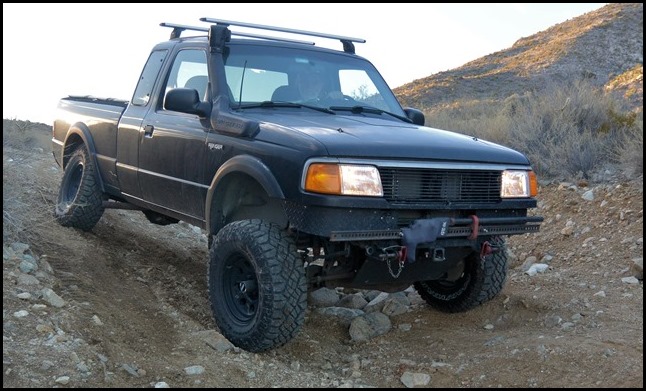
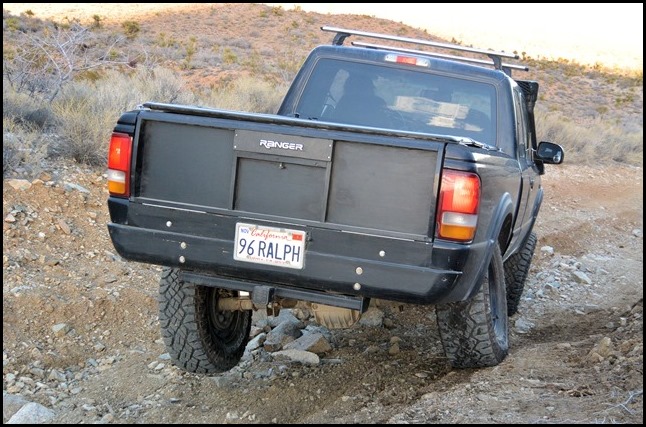
HAPPY NEW YEAR,
WISH WE WERE THERE.
MERRILL HAS JURY DUDY THIS YEAR.
WILL BE COMING UP TOO CAMP VERY VERY SOON ,
WITHIN THE NEXT TWO WEEKS.
SORRY TO HAVE MISSED YOU TWO
YOUR PICTURES ARE WONDERFUL.
HAVE A HEALTHY HAPPY NEW YEAR,
WITH LOTS OF BLESSING
HAPPY TRAILS
MERRILL, BARBARA
& BAILEY
Hey Barbara,
we were thinking about you, but we only had a week to “stop by”, and we too have callings at home.
Hopefully another time when we can cross paths again.
(Rain, hail, and thunder last night welcomed us to 2017.)
Happy New Year to you both,
G.